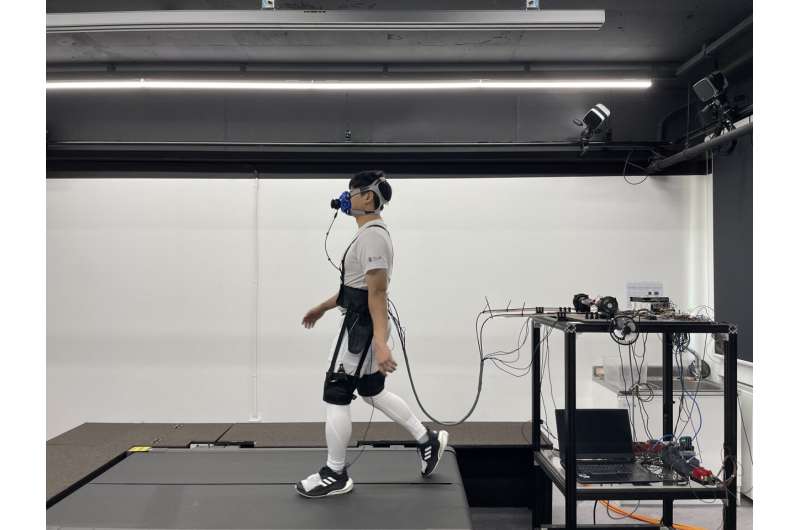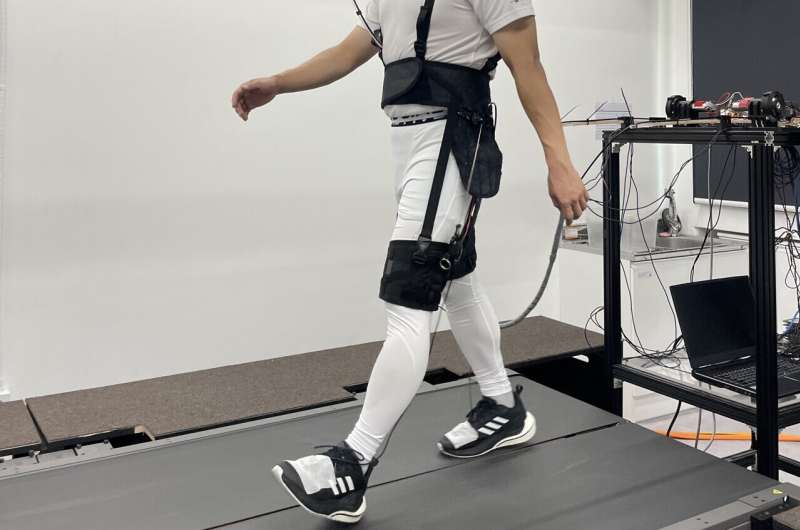A wearable robot that assists people with walking

In recent years, roboticists have introduced increasingly advanced systems, which could open exciting new possibilities for surgery, rehabilitation, and health care assistance. These robotic systems are already helping to improve the quality of life of many people with disabilities, as well as patients who suffered physical trauma or underwent medical procedures.
Researchers at Chung-Ang University in South Korea recently introduced a new wearable robot designed to specifically assist humans who have difficulties walking due to aging, muscle weakness, surgeries or specific medical conditions. This robot, presented in a paper published in Science Robotics, was found to improve balance, while also reducing the energy spent while walking (i.e., the so-called metabolic cost).
“Our recent paper was primarily inspired by the recognition that most wearable robots for gait assistance have focused solely on movements in the sagittal plane,” Giuk Lee, one of the researchers who carried out the study, told Tech Xplore. “However, walking is inherently a three-dimensional activity, and movements in other planes are just as crucial.”
In contrast with other robotic systems for hip abduction assistance proposed in the past, the robot created by Lee and his colleagues focuses on the frontal plane. This is the frontal part of the human body, known to support movements and lateral stability while walking.
“Traditionally, research on walking motion has considered forward movement and lateral balance as separate functions,” Myunghee Kim, co-author of the paper, said. “Only recently has the fore-aft direction’s assistance been acknowledged for its contribution to lateral stability. Yet, the reverse—the influence of lateral assistance on fore-aft walking efficiency—remains insufficiently explored.”
The key assumption behind the researchers’ study is that the metabolic cost of walking could be reduced using wearable robots that mimic the natural hip abduction moment. This is the movement of the leg away from the body’s midline, which supports walking and many other actions humans perform every day.

“The wearable robot for hip abduction assistance that we’ve developed operates on the principle that walking efficiency can be improved by supporting lateral body movements,” Lee said. “As we walk forward, our body’s center of mass naturally shifts side to side to maintain balance—a process known as recovery. During this recovery phase, the hip abduction muscles are engaged. Our device assists these muscles, making it easier for the wearer to recover their center of mass with less effort.”
Lee and his colleagues evaluated their robot’s performance in both simulations and real-world experiments. The results of these tests were highly promising, showing that the robot reduced the metabolic cost of walking by 11.6% compared to normal, unassisted walking, while also improving balance and stability.
“Our study demonstrates that enhancing gait efficiency doesn’t require the wearable robot to focus only on the sagittal plane,” Lee said. “Since walking is a three-dimensional motion, it’s essential to consider movements across various planes.”
Essentially, the hip abduction assistance robot developed by Lee and his colleagues influences the movements of the hips and legs known to support walking. Its unique design allows it to effectively ‘replace’ part of the efforts that humans would normally place when walking.
“Our study demonstrates a substantial role for lateral assistance in enhancing walking efficiency by facilitating a more effective transfer of the body’s center of mass from one foot to the other,” Kim added. “This insight is especially encouraging for individuals with reduced muscle strength, offering a new direction for support mechanisms. Moving forward, it will be important to explore how lateral assistance could help those with limited mobility, potentially transforming rehabilitation and support strategies.”
In the future, the robotic system developed by this team of researchers could be improved further and eventually commercialized, supporting both rehabilitation and everyday use. The robot could prove useful for older adults, patients who underwent leg or hip surgeries, and other people who experience difficulties walking.
“For future research, we plan to delve deeper into how hip abduction affects walking balance,” Lee added. “We’ve observed that hip abduction not only improves gait efficiency but may also influence balance. We aim to explore the potential of wearable robots in enhancing walking balance.”
More information:
Juneil Park et al, Effect of hip abduction assistance on metabolic cost and balance during human walking. Science Robotics (2023). DOI: 10.1126/scirobotics.ade0876.
© 2023 Science X Network
Citation:
A wearable robot that assists people with walking (2023, November 21)
retrieved 22 November 2023
from https://techxplore.com/news/2023-11-wearable-robot-people.html
This document is subject to copyright. Apart from any fair dealing for the purpose of private study or research, no
part may be reproduced without the written permission. The content is provided for information purposes only.
For all the latest Technology News Click Here
For the latest news and updates, follow us on Google News.

